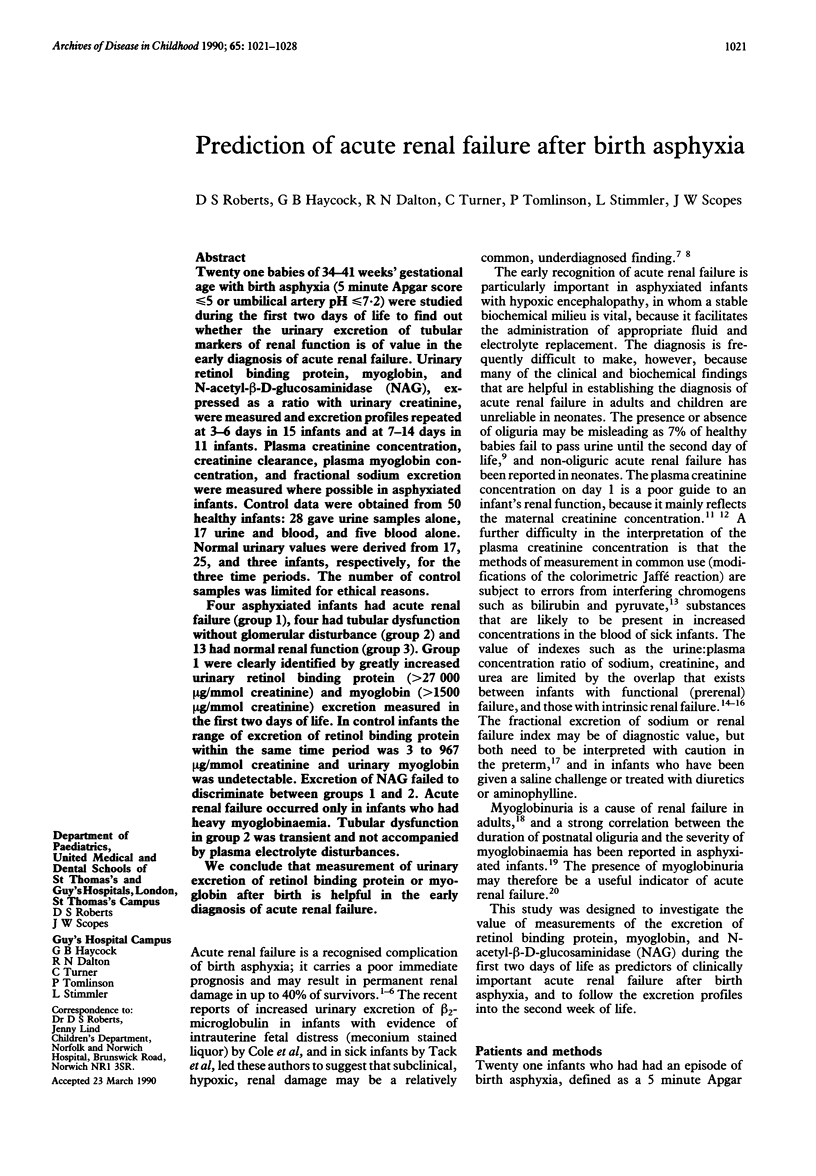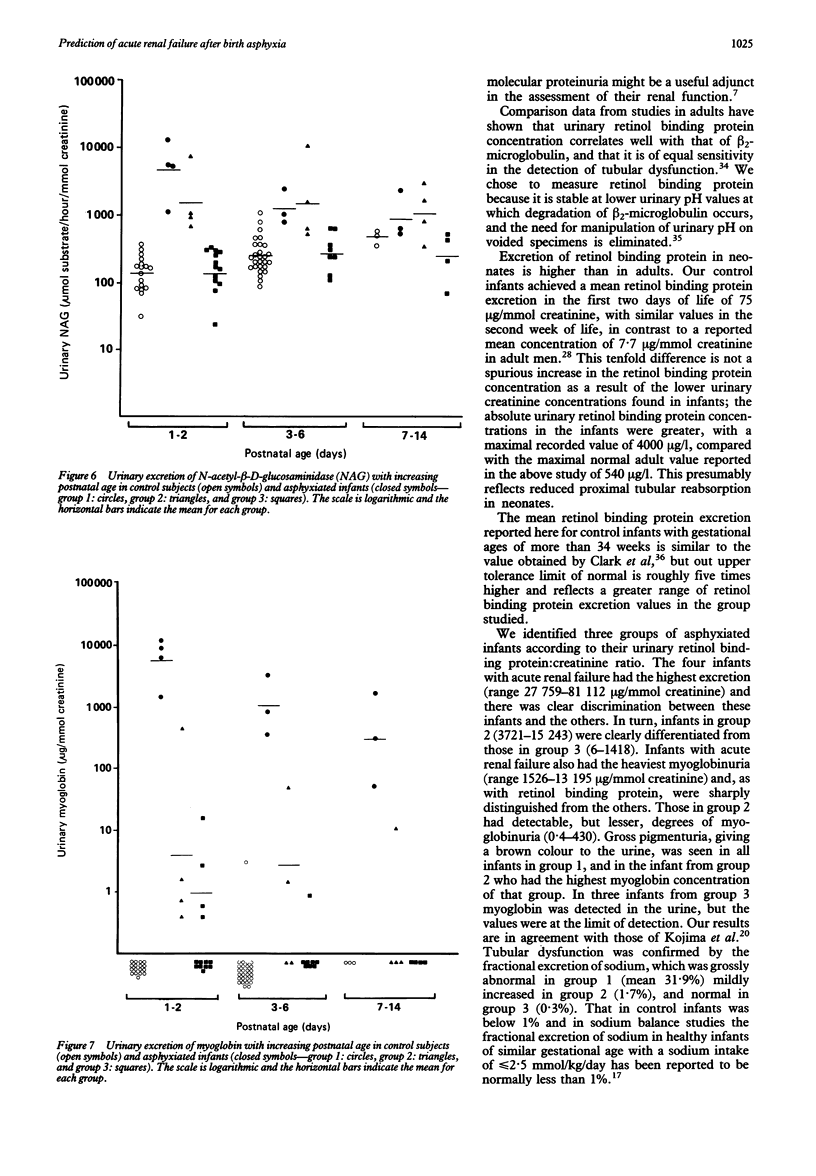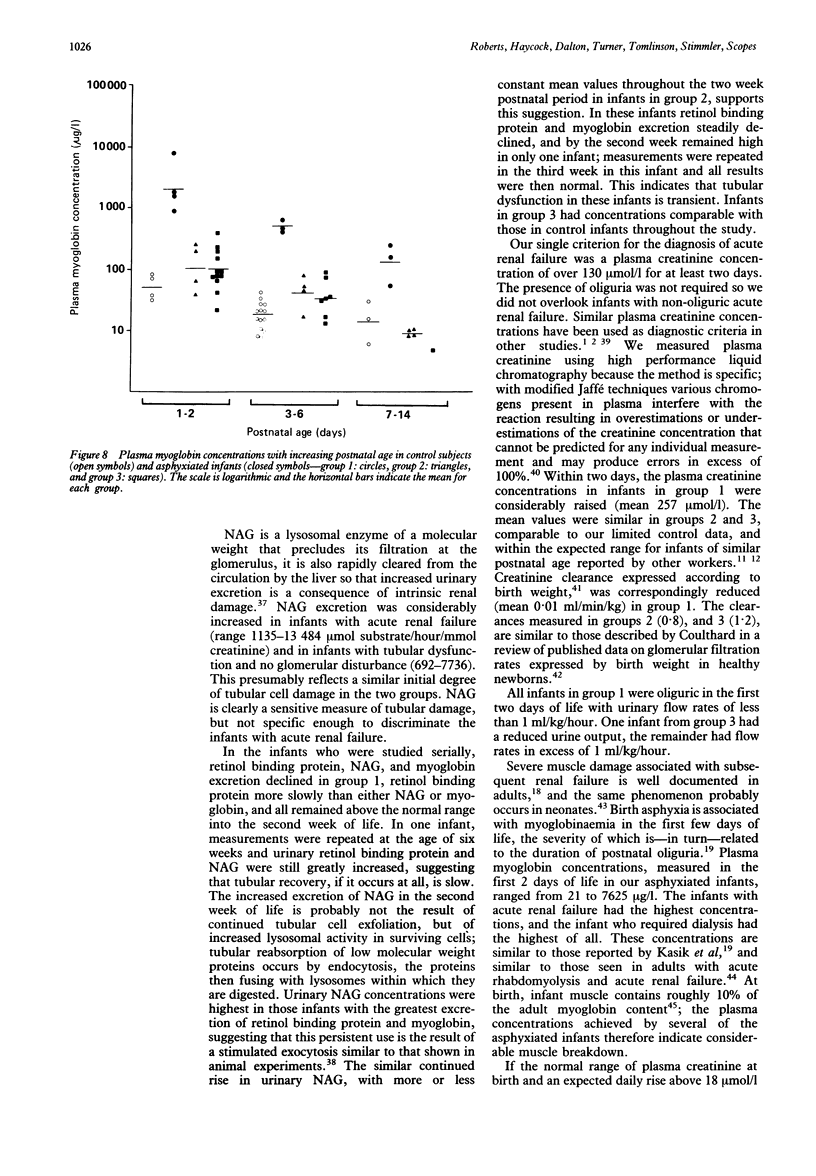Abstract
Twenty-one babies of 34-41 weeks' gestational age with birth asphyxia (5 minute Apgar score less than or equal to 5 or umbilical artery pH less than or equal to 7.2) were studied during the first two days of life to find out whether the urinary excretion of tubular markers of renal function is of value in the early diagnosis of acute renal failure. Urinary retinol binding protein, myoglobin, and N-acetyl-beta-D-glucosaminidase (NAG), expressed as a ratio with urinary creatinine, were measured and excretion profiles repeated at 3-6 days in 15 infants and at 7-14 days in 11 infants. Plasma creatinine concentration, creatinine clearance, plasma myoglobin concentration, and fractional sodium excretion were measured where possible in asphyxiated infants. Control data were obtained from 50 healthy infants: 28 gave urine samples alone, 17 urine and blood, and five blood alone. Normal urinary values were derived from 17, 25, and three infants, respectively, for the three time periods. The number of control samples was limited for ethical reasons. Four asphyxiated infants had acute renal failure (group 1), four had tubular dysfunction without glomerular disturbance (group 2) and 13 had normal renal function (group 3). Group 1 were clearly identified by greatly increased urinary retinol binding protein (greater than 27,000 micrograms/mmol creatinine) and myoglobin (greater than 1500 micrograms/mmol creatinine) excretion measured in the first two days of life. In control infants the range of excretion of retinol binding protein within the same time period was 3 to 967 micrograms/mmol creatinine and urinary myoglobin was undetectable. Excretion of NAG failed to discriminate between groups 1 and 2. Acute renal failure occurred only in infants who had heavy myoglobinaemia. Tubular dysfunction in group 2 was transient and not accompanied by plasma electrolyte disturbances. We conclude that measurement of urinary excretion of retinol binding protein or myoglobin after birth is helpful in the early diagnosis of acute renal failure.
Full text
PDF







Selected References
These references are in PubMed. This may not be the complete list of references from this article.
- Al-Dahhan J., Haycock G. B., Chantler C., Stimmler L. Sodium homeostasis in term and preterm neonates. I. Renal aspects. Arch Dis Child. 1983 May;58(5):335–342. doi: 10.1136/adc.58.5.335. [DOI] [PMC free article] [PubMed] [Google Scholar]
- Ambrose R. T., Ketchum D. F., Smith J. W. Creatinine determined by "high-performance" liquid chromatography. Clin Chem. 1983 Feb;29(2):256–259. [PubMed] [Google Scholar]
- Anand S. K. Acute renal failure in the neonate. Pediatr Clin North Am. 1982 Aug;29(4):791–800. doi: 10.1016/s0031-3955(16)34212-2. [DOI] [PubMed] [Google Scholar]
- Anand S. K., Northway J. D., Crussi F. G. Acute renal failure in newborn infants. J Pediatr. 1978 Jun;92(6):985–988. doi: 10.1016/s0022-3476(78)80383-7. [DOI] [PubMed] [Google Scholar]
- Bernard A., Amor A. O., Viau C., Lauwerys R. The renal uptake of proteins: a nonselective process in conscious rats. Kidney Int. 1988 Aug;34(2):175–185. doi: 10.1038/ki.1988.163. [DOI] [PubMed] [Google Scholar]
- Chevalier R. L., Campbell F., Brenbridge A. N. Prognostic factors in neonatal acute renal failure. Pediatrics. 1984 Aug;74(2):265–272. [PubMed] [Google Scholar]
- Clark P. M., Bryant T. N., Hall M. A., Lowes J. A., Rowe D. J. Neonatal renal function assessment. Arch Dis Child. 1989 Sep;64(9):1264–1269. doi: 10.1136/adc.64.9.1264. [DOI] [PMC free article] [PubMed] [Google Scholar]
- Cole J. W., Portman R. J., Lim Y., Perlman J. M., Robson A. M. Urinary beta 2-microglobulin in full-term newborns: evidence for proximal tubular dysfunction in infants with meconium-stained amniotic fluid. Pediatrics. 1985 Dec;76(6):958–964. [PubMed] [Google Scholar]
- Coulthard M. G., Hey E. N. Weight as the best standard for glomerular filtration in the newborn. Arch Dis Child. 1984 Apr;59(4):373–375. doi: 10.1136/adc.59.4.373. [DOI] [PMC free article] [PubMed] [Google Scholar]
- Coulthard M. G. Maturation of glomerular filtration in preterm and mature babies. Early Hum Dev. 1985 Sep;11(3-4):281–292. doi: 10.1016/0378-3782(85)90082-9. [DOI] [PubMed] [Google Scholar]
- Dauber I. M., Krauss A. N., Symchych P. S., Auld P. A. Renal failure following perinatal anoxia. J Pediatr. 1976 May;88(5):851–855. doi: 10.1016/s0022-3476(76)81130-4. [DOI] [PubMed] [Google Scholar]
- Davey P. G., Gosling P. beta 2-Microglobulin instability in pathological urine. Clin Chem. 1982 Jun;28(6):1330–1333. [PubMed] [Google Scholar]
- Demos M. A., Gitin E. L., Kagen L. J. Exercise myoglobinemia and acute exertional rhabdomyolysis. Arch Intern Med. 1974 Oct;134(4):669–673. [PubMed] [Google Scholar]
- Dubowitz L. M., Dubowitz V., Goldberg C. Clinical assessment of gestational age in the newborn infant. J Pediatr. 1970 Jul;77(1):1–10. doi: 10.1016/s0022-3476(70)80038-5. [DOI] [PubMed] [Google Scholar]
- Elinder G., Aperia A. Development of glomerular filtration rate and excretion of beta 2-microglobulin in neonates during gentamicin treatment. Acta Paediatr Scand. 1983 Mar;72(2):219–224. doi: 10.1111/j.1651-2227.1983.tb09701.x. [DOI] [PubMed] [Google Scholar]
- Ellis E. N., Arnold W. C. Use of urinary indexes in renal failure in the newborn. Am J Dis Child. 1982 Jul;136(7):615–617. doi: 10.1001/archpedi.1982.03970430047013. [DOI] [PubMed] [Google Scholar]
- Gibb D. M., Tomlinson P. A., Dalton N. R., Turner C., Shah V., Barratt T. M. Renal tubular proteinuria and microalbuminuria in diabetic patients. Arch Dis Child. 1989 Jan;64(1):129–134. doi: 10.1136/adc.64.1.129. [DOI] [PMC free article] [PubMed] [Google Scholar]
- Grossman R. A., Hamilton R. W., Morse B. M., Penn A. S., Goldberg M. Nontraumatic rhabdomyolysis and acute renal failure. N Engl J Med. 1974 Oct 17;291(16):807–811. doi: 10.1056/NEJM197410172911601. [DOI] [PubMed] [Google Scholar]
- Grylack L., Medani C., Hultzen C., Sivasubramanian K., Davitt M. K., Jose P., Scanlon J. W. Nonoliguric acute renal failure in the newborn: a prospective evaluation of diagnostic indexes. Am J Dis Child. 1982 Jun;136(6):518–520. doi: 10.1001/archpedi.1982.03970420042008. [DOI] [PubMed] [Google Scholar]
- Haftel A. J., Eichner J., Haling J., Wilson M. L. Myoglobinuric renal failure in a newborn infant. J Pediatr. 1978 Dec;93(6):1015–1016. doi: 10.1016/s0022-3476(78)81241-4. [DOI] [PubMed] [Google Scholar]
- Huang Y. C., Chiou W. L. Creatinine XII: comparison of assays of low serum creatinine levels using high-performance liquid chromatography and two picrate methods. J Pharm Sci. 1983 Jul;72(7):836–837. doi: 10.1002/jps.2600720736. [DOI] [PubMed] [Google Scholar]
- Kagen L. J., Christian C. L. Immunologic measurements of myoglobin in human adult and fetal skeletal muscle. Am J Physiol. 1966 Sep;211(3):656–660. doi: 10.1152/ajplegacy.1966.211.3.656. [DOI] [PubMed] [Google Scholar]
- Kasik J. W., Leuschen M. P., Bolam D. L., Nelson R. M. Rhabdomyolysis and myoglobinemia in neonates. Pediatrics. 1985 Aug;76(2):255–258. [PubMed] [Google Scholar]
- Kojima T., Kobayashi T., Matsuzaki S., Iwase S., Kobayashi Y. Effects of perinatal asphyxia and myoglobinuria on development of acute, neonatal renal failure. Arch Dis Child. 1985 Oct;60(10):908–912. doi: 10.1136/adc.60.10.908. [DOI] [PMC free article] [PubMed] [Google Scholar]
- Maruhn D. Rapid colorimetric assay of beta-galactosidase and N-acetyl-beta-glucosaminidase in human urine. Clin Chim Acta. 1976 Dec;73(3):453–461. doi: 10.1016/0009-8981(76)90147-9. [DOI] [PubMed] [Google Scholar]
- Mathew O. P., Jones A. S., James E., Bland H., Groshong T. Neonatal renal failure: usefulness of diagnostic indices. Pediatrics. 1980 Jan;65(1):57–60. [PubMed] [Google Scholar]
- Meeks A. C., Sims D. G. Treatment of renal failure in neonates. Arch Dis Child. 1988 Nov;63(11):1372–1376. doi: 10.1136/adc.63.11.1372. [DOI] [PMC free article] [PubMed] [Google Scholar]
- Norman M. E., Asadi F. K. A prospective study of acute renal failure in the newborn infant. Pediatrics. 1979 Mar;63(3):475–479. [PubMed] [Google Scholar]
- Olavarría F., Krause S., Barranco L., Herrmann F., Paez V., Mezzano S., Leal N., López M. Renal function in full-term newborns following neonatal asphyxia. A prospective study. Clin Pediatr (Phila) 1987 Jul;26(7):334–338. doi: 10.1177/000992288702600702. [DOI] [PubMed] [Google Scholar]
- Roberts D. S., Rendell B. Postmicturition residual bladder volumes in healthy babies. Arch Dis Child. 1989 Jun;64(6):825–828. doi: 10.1136/adc.64.6.825. [DOI] [PMC free article] [PubMed] [Google Scholar]
- Rudd P. T., Hughes E. A., Placzek M. M., Hodes D. T. Reference ranges for plasma creatinine during the first month of life. Arch Dis Child. 1983 Mar;58(3):212–215. doi: 10.1136/adc.58.3.212. [DOI] [PMC free article] [PubMed] [Google Scholar]
- SHERRY S. N., KRAMER I. The time of passage of the first stool and first urine by the newborn infant. J Pediatr. 1955 Feb;46(2):158–159. doi: 10.1016/s0022-3476(55)80205-3. [DOI] [PubMed] [Google Scholar]
- Schlesinger P., Rodman J. S., Frey M., Lang S., Stahl P. Clearance of lysosomal hydrolases following intravenous infusion. The role of liver in the clearance of beta-glucuronidase and N-acetyl-beta-D-glucosaminidase. Arch Biochem Biophys. 1976 Dec;177(2):606–614. doi: 10.1016/0003-9861(76)90472-0. [DOI] [PubMed] [Google Scholar]
- Spencer K. Analytical reviews in clinical biochemistry: the estimation of creatinine. Ann Clin Biochem. 1986 Jan;23(Pt 1):1–25. doi: 10.1177/000456328602300101. [DOI] [PubMed] [Google Scholar]
- Stapleton F. B., Jones D. P., Green R. S. Acute renal failure in neonates: incidence, etiology and outcome. Pediatr Nephrol. 1987 Jul;1(3):314–320. doi: 10.1007/BF00849230. [DOI] [PubMed] [Google Scholar]
- Tack E. D., Perlman J. M., Robson A. M. Renal injury in sick newborn infants: a prospective evaluation using urinary beta 2-microglobulin concentrations. Pediatrics. 1988 Mar;81(3):432–440. [PubMed] [Google Scholar]
- Tarlow M. J. Urine and stool collection for metabolic studies in the newborn. Arch Dis Child. 1974 Jun;49(6):490–492. doi: 10.1136/adc.49.6.490. [DOI] [PMC free article] [PubMed] [Google Scholar]
- Topping M. D., Forster H. W., Dolman C., Luczynska C. M., Bernard A. M. Measurement of urinary retinol-binding protein by enzyme-linked immunosorbent assay, and its application to detection of tubular proteinuria. Clin Chem. 1986 Oct;32(10):1863–1866. [PubMed] [Google Scholar]
- Trompeter R. S., Al-Dahhan J., Haycock G. B., Chik G., Chantler C. Normal values for plasma creatinine concentration related to maturity in normal term and preterm infants. Int J Pediatr Nephrol. 1983 Sep;4(3):145–148. [PubMed] [Google Scholar]
- Watanabe K., Kojima T., Fukuda Y., Ohbayashi K., Kobayashi T., Iwase S., Kobayashi Y. Reliability of urinary N-acetyl-beta-D-glucosaminidase as an indicator of renal tubular damage in neonates. Biol Neonate. 1987;52(1):16–21. doi: 10.1159/000242679. [DOI] [PubMed] [Google Scholar]
- Wellwood J. M., Ellis B. G., Price R. G., Hammond K., Thompson A. E., Jones N. F. Urinary N-acetyl- beta-D-glucosaminidase activities in patients with renal disease. Br Med J. 1975 Aug 16;3(5980):408–411. doi: 10.1136/bmj.3.5980.408. [DOI] [PMC free article] [PubMed] [Google Scholar]


